Thread on r/Mastodon
This thread on r/Mastodon is going to be important, especially considering I do not have easy access to an iPad.
Open extratone opened 3 years ago
This thread on r/Mastodon is going to be important, especially considering I do not have easy access to an iPad.
mastodon ios apps - Google Search https://www.google.com/search?q=mastodon+ios+apps&sxsrf=ALeKk00OI6BE-qcLf1j_S0YnNlR7xl1_mw:1621858355371&ei=M5irYJOLFtPLtQb9gLrYAQ&start=110&sa=N&ved=2ahUKEwjT8JaZpeLwAhXTZc0KHX2ADhs4ZBDy0wN6BAgBEEE&biw=2092&bih=1067
🎓 Dr. Freemo :jpf: 🇳🇱: "Holy crap, google is apparently taking down all/m…" - Qoto Mastodon https://qoto.org/@freemo/104765288863293481
A Beginner’s Guide to Mastodon https://lifehacker.com/a-beginner-s-guide-to-mastodon-1828503235
What I wish I knew before joining Mastodon | Hacker Noon https://hackernoon.com/what-i-wish-i-knew-before-joining-mastodon-7a17e7f12a2b
openoms: "@zlok Did you try the iOS apps listed here: https…" - Bitcoin Mastodon https://bitcoinhackers.org/@openoms/104256746838301039
Mastodon Is Like Twitter Without Nazis, So Why Are We Not Using It? https://www.vice.com/en/article/783akg/mastodon-is-like-twitter-without-nazis-so-why-are-we-not-using-it
Many Indians are moving to Mastodon from Twitter: Why, what is Mastodon and how it works https://www.indiatoday.in/technology/news/story/indians-leaving-twitter-join-mastodon-what-is-it-how-does-it-work-1617030-2019-11-08
How Does Mastodon Work? - Kev Quirk https://kevq.uk/how-does-mastodon-work/
The complete guide to using Mastodon, the Twitter (TWTR) alternative. — Quartz https://qz.com/951078/the-complete-guide-to-using-mastodon-the-twitter-twtr-alternative/
Join me on Mastodon | Danny van Kooten https://dannyvankooten.com/join-mastodon/
Introducing the new TWiT Mastodon - Announcements - TWiT.Community https://www.twit.community/t/introducing-the-new-twit-mastodon/5073
Ella Black: "Is there an app for switter?" - Switter https://switter.at/@missellablack/99790943174060896
Six reasons Mastodon won't survive https://mashable.com/2017/04/05/mastodon-wont-survive/
An Incomplete Guide to Getting Started on Mastodon https://davidwolfpaw.com/getting-started-on-mastodon/
Oyakodon for Mastodon for iPhone & iPad https://appfelstrudel.com/id/1229174544/oyakodon-for-mastodon.html
Oyakodon for Mastodon on the App Store https://apps.apple.com/us/app/oyakodon-for-mastodon/id1229174544#?platform=iphone
Ore2 for Twitter & Mastodon 1.99USD https://appfelstrudel.com/id/1107176601/ore2-for-twitter-mastodon.html
Ore2 for Twitter & Mastodon $1.99 - 4.7/5 stars https://apps.apple.com/us/app/ore2-for-twitter-mastodon/id1107176601?ign-mpt=uo%3D4
Tootle (@tootleapp@mastodon.cloud) - mastodon.cloud https://mastodon.cloud/@tootleapp
「マストドンアプリ「Tootle for Mastodon」」をApp Storeで https://apps.apple.com/jp/app/%E3%83%9E%E3%82%B9%E3%83%88%E3%83%89%E3%83%B3%E3%82%A2%E3%83%97%E3%83%AA-tootle-for-mastodon/id1236013466#?platform=iphone
Mercury for Mastodon https://onmercury.app/
Tusk for iOS http://tusk.webflow.io/
Toni Lampela: "Posting form my new favorite mastodon iOS app Met…" - mastodon.toni.im https://mastodon.toni.im/@toni/105944191806274557
Apps · Mastodon Docs https://bmann.gitbooks.io/mastodon-docs/content/Using-Mastodon/Apps.html
DavidLibeau/mastodon-tools: Useful tools for Mastodon users ! https://github.com/davidlibeau/mastodon-tools
Home | Open-Source iOS Apps https://open-source-ios-apps.netlify.app/category/mastodon/
Mercury for Mastodon | AppleVis https://www.applevis.com/apps/ios/social-networking/mercury-mastodon
https://whyp.it/t/toot-ios-app-custom-sounds-92997https://github.com/extratone/bilge/raw/main/audio/Toot!%20Custom%20Sounds.mp3http://bit.ly/tootappstoreEmbed
<audio controls>
<source src="https://github.com/extratone/bilge/raw/main/audio/Toot!%20Custom%20Sounds.mp3">
</audio>https://social.wake.st/@liaizon/106309583561555349
there’s a few I see you haven’t mentioned. Here’s my folder of fediverse iOS apps I am trying


https://bit.ly/duduios https://mastodon.technology/@DavidBlue/100950164113791375
https://apps.apple.com/us/app/roma-for-pleroma-and-mastodon/id1445328699
(Which is very clearly what used to be called Mast lmao)


| Action | Key |
|---|---|
| Open Compose Window | ⌘ + N |
| Send Toot | ⌘ + Return |
| Home Timeline | ⌘ + 1 |
| Notifications | ⌘ + 2 |
| Local Timeline | ⌘ + 3 |
| Others (Menu) | ⌘ + 9 |

Notably a social card for a live Twitter broadcast while it was still live.
https://tools.applemediaservices.com/app-store/
==Mercury takes a zero tolerence stance on abuse and harassment and as such does not support many instances that promote abuse and harassment.==
Instance Reason rainbowdash.net Advice of toot.cat/cybre.space admins, GNUSocial apparent free speech zone™ shitposter.club Advice of toot.cat/cybre.space admins, GNUSocial apparent free speech zone™ , hosts fake Gargron account freezepeach.xyz Advice of toot.cat/cybre.space admins, GNUSocial apparent free speech zone™ social.heldscal.la Advice of toot.cat/cybre.space admins, GNUSocial apparent free speech zone™ woofer.alfter.us Advice of toot.cat admin, GNUSocial apparent free speech zone™ social.au2pb.net Advice of toot.cat admin, GNUSocial apparent free speech zone™ gorf.club Advice of toot.cat admin, GNUSocial apparent free speech zone™ sealion.club Advice of toot.cat/cybre.space admins, GNUSocial apparent free speech zone™ gs.smu.li Advice of toot.cat admin, GNUSocial apparent free speech zone™ , lolicon unsafe.space Advice of toot.cat admin, GNUSocial apparent free speech zone™ pa.net lolicon wrongthink.net GNUSocial apparent free speech zone™ ediot.social Apparent free speech zone™ social.targaryen.house Apparent free speech zone™ noagendasocial.com Apparent free speech zone™ social.au2pb.net Advice of Dzuk’s BLOCKchain ika.moe Advice of Dzuk’s BLOCKchain anitwitter.moe Advice of Dzuk’s BLOCKchain bsd.moe Harassment catgirl.life Harassment cnet.site Harassment fem*.lgbt Underage porn kiwifarms.cc Harassment kiwifarms.net Harassment la***.online Allows untagged gore lets.saynoto.lgbt Harassment npf.mlpol.net —- pieville.net Harassment pl.smuglo.li Violent speech zone wagesofsinisdeath.com Violent speech zone waifuappreciation.club Violent speech zone rapefeminists.network Don’t need to explain this one. baraag.net Advice of Dzuk’s BLOCKchain social.allthefallen.ninja Advice of Dzuk’s BLOCKchain social.homunyan.com Advice of Dzuk’s BLOCKchain pre.biz Advice of Dzuk’s BLOCKchain social.hidamari.blue Advice of Dzuk’s BLOCKchain libertarianism.club Advice of Dzuk’s BLOCKchain toot.love Advice of Dzuk’s BLOCKchain pl.smu*.li Advice of Dzuk’s BLOCKchain pleroma.cucked.me Advice of Dzuk’s BLOCKchain voluntaryism.club Advice of Dzuk’s BLOCKchain bofa.lol harassment, brigading thechad.zone harassment, advice of Dzuk’s BLOCKchain newjack.city spammy bot activity daffodil-11.org Identified by Firefox as a malicious site gab.com Extremism, free speech zone™ gab.ai Extremism, free speech zone™ societal.co Extremism, free speech zone™ spinster.xyz Extremism, free speech zone™ exited.eu Extremism, free speech zone™ freespeechextremist.com Free speech zone™ Free speech as in promotion or lack of moderation around National Socialisim, QAnon, and that one thing that happened early Jan 2021, among other things.
Mercury takes a zero tolerence stance on abuse and harassment and as such does not support many instances that promote abuse and harassment.
| Instance | Reason |
|---|---|
| rainbowdash.net | Advice of toot.cat/cybre.space admins, GNUSocial apparent free speech zone™ ** |
| shitposter.club | Advice of toot.cat/cybre.space admins, GNUSocial apparent free speech zone™ **, hosts fake Gargron account |
| freezepeach.xyz | Advice of toot.cat/cybre.space admins, GNUSocial apparent free speech zone™ ** |
| social.heldscal.la | Advice of toot.cat/cybre.space admins, GNUSocial apparent free speech zone™ ** |
| woofer.alfter.us | Advice of toot.cat admin, GNUSocial apparent free speech zone™ ** |
| social.au2pb.net | Advice of toot.cat admin, GNUSocial apparent free speech zone™ ** |
| gorf.club | Advice of toot.cat admin, GNUSocial apparent free speech zone™ ** |
| sealion.club | Advice of toot.cat/cybre.space admins, GNUSocial apparent free speech zone™ ** |
| gs.smu***.li | Advice of toot.cat admin, GNUSocial apparent free speech zone™ **, lolicon*** |
| unsafe.space | Advice of toot.cat admin, GNUSocial apparent free speech zone™ ** |
| pa***.net | lolicon*** |
| wrongthink.net | GNUSocial apparent free speech zone™ ** |
| ediot.social | Apparent free speech zone™ ** |
| social.targaryen.house | Apparent free speech zone™ ** |
| noagendasocial.com | Apparent free speech zone™ ** |
| social.au2pb.net | Advice of Dzuk’s BLOCKchain |
| ika.moe | Advice of Dzuk’s BLOCKchain |
| anitwitter.moe | Advice of Dzuk’s BLOCKchain |
| bsd.moe | Harassment |
| catgirl.life | Harassment |
| cnet.site | Harassment |
| fem*****.lgbt | Underage porn |
| kiwifarms.cc | Harassment |
| kiwifarms.net | Harassment |
| la****.online | Allows untagged gore |
| lets.saynoto.lgbt | Harassment |
| npf.mlpol.net | —- |
| pieville.net | Harassment |
| pl.smuglo.li | Violent speech zone |
| wagesofsinisdeath.com | Violent speech zone |
| waifuappreciation.club | Violent speech zone |
| rapefeminists.network | Don’t need to explain this one. |
| baraag.net | Advice of Dzuk’s BLOCKchain |
| social.allthefallen.ninja | Advice of Dzuk’s BLOCKchain |
| social.homunyan.com | Advice of Dzuk’s BLOCKchain |
| pre*****.biz | Advice of Dzuk’s BLOCKchain |
| social.hidamari.blue | Advice of Dzuk’s BLOCKchain |
| libertarianism.club | Advice of Dzuk’s BLOCKchain |
| toot.love | Advice of Dzuk’s BLOCKchain |
| pl.smu***.li | Advice of Dzuk’s BLOCKchain |
| pleroma.cucked.me | Advice of Dzuk’s BLOCKchain |
| voluntaryism.club | Advice of Dzuk’s BLOCKchain |
| bofa.lol | harassment, brigading |
| thechad.zone | harassment, advice of Dzuk’s BLOCKchain |
| newjack.city | spammy bot activity |
| daffodil-11.org | Identified by Firefox as a malicious site |
| gab.com | Extremism, free speech zone™ ** |
| gab.ai | Extremism, free speech zone™ ** |
| societal.co | Extremism, free speech zone™ ** |
| spinster.xyz | Extremism, free speech zone™ ** |
| exited.eu | Extremism, free speech zone™ ** |
| freespeechextremist.com | Free speech zone™ ** |
** Free speech as in promotion or lack of moderation around National Socialisim, QAnon, and that one thing that happened early Jan 2021, among other things.


Jun 23, 2021 at 12:00 __ Written by Ernie Smith on Jun 23, 2021
__ app store, apple, applications, digital downloads, downloads, microsoft, NeXT, nokia, NTT DoCoMo, smartphones
Today in Tedium: How much credit does Apple deserve for introducing the App Store concept to mainstream consumers? I mean, how obvious is the idea, anyway? (We’ll leave the whole 30 percent question for the courts to decide.) This is a question that seems worth asking as modern app development has become so centered around building applications that exist in digital storefronts like Apple’s App Store, the Google Play Store, Steam, and numerous others. I’m just imagining how Apple would have done it otherwise—putting little memory cards into the side of the iPhone, like you still have the option to do on the Switch? For numerous reasons, shrink wrap was going to go the way of the dodo eventually. But what about app stores that existed when the proverbial dodo was still around—why don’t we talk about those for a little while and get an understanding of the broader lessons we can gain from them? With that in mind, today’s Tedium ponders the app stores before the App Store. — Ernie @ Tedium
Today’s GIF comes from a commercial for i-mode, the Japanese store widely seen as the first mobile app store.
— Michael Robertson, the software developer best known for his creation of MP3.com, in a blog post discussing his work on “Click-N-Run,” an early attempt at creating a digital download store along the lines of the App Store in the early 2000s. Click-N-Run (CNR), which was an aspect of the commercial Windows-like Linux distribution Linspire that Robertson helped build, was a commercial GUI-style interface for Debian’s apt package manager. It was eventually made available to other distros to much interest, though the results were reportedly a mixed bag. While no longer made, Linspire’s work on CNR (one of a few stabs at the GUI-based software distribution interface in Linux) likely inspired the graphical package managers now commonly offered with many Linux distributions, which largely work the same way.
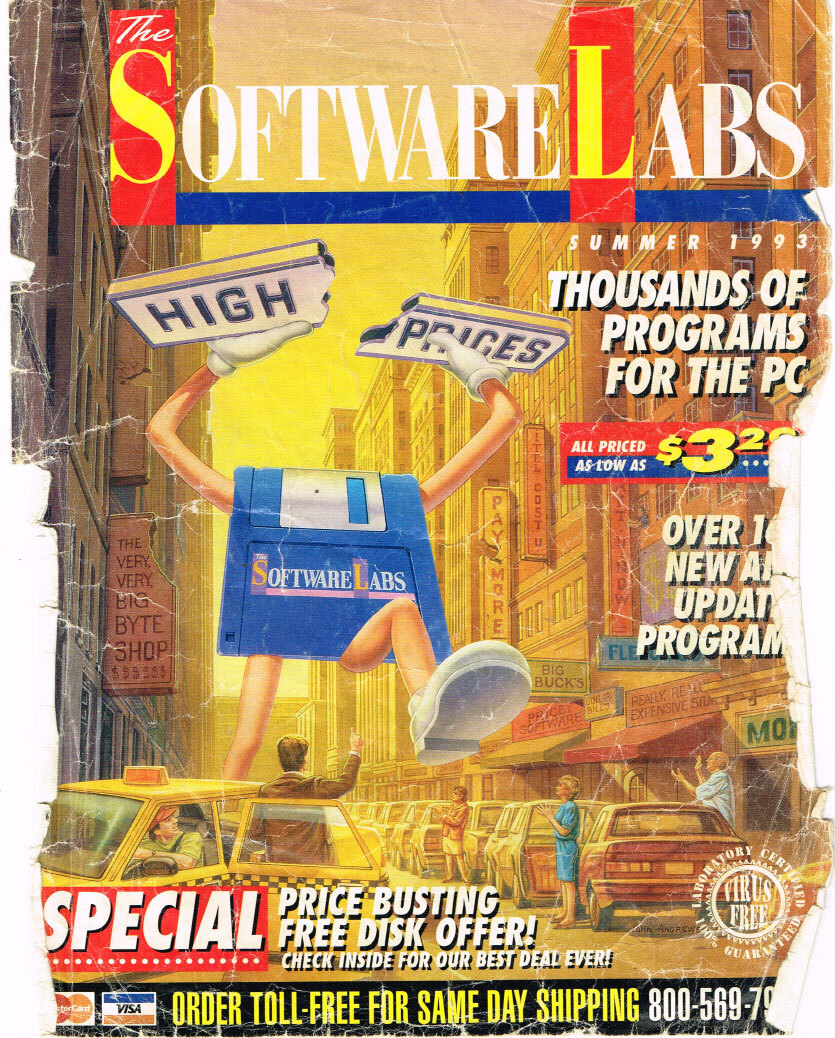
A 1993 catalog for The Software Labs, a distributor of shareware through the mail. There was once a time that buying full versions of programs meant sending a physical check. (via the Internet Archive)
Let’s play a game: If you were to access a piece of shareware circa 1991 and wanted to unlock the full version of that application with your computer alone, how would you do it?
No web. Perhaps no Windows. (Perhaps GeoWorks.)
Sure, there were probably lots of ways to download an application, if you had the tools to do so—as in, a modem. Perhaps you might grab it on a BBS, or through a service like Compuserve. Maybe Usenet binary groups were your preferred strategy.
But still, you’d be stuck with a nag screen. Your copy of WinZip would just be annoying you every time you started it.
See, the issue with the distribution of software via computer was never about the download part—that part was figured out relatively quickly. It was the paying part that proved difficult.
Think about how it might work compared to a store: You choose a physical object of interest, you give a physical object of value (i.e. money) in exchange, an intermediary (i.e. a cashier) confirms you bought it (by scanning a barcode), and you walk out, without an object of value but with an object of interest.
Which is why every time you read a story about some shareware pioneer, like the developer of Paint Shop Pro or Tim Sweeney’s efforts to sell folks ZZT, it’s always paired with a story about these developers literally taking checks in the mail, despite the fact that it was entirely possible to purchase things fully electronically with a credit card by this point.
Without the retail element, people were kind of stuck distributing software without a way to easily purchase it. (What’s the big deal, the open-source folks say.) There was no way to secure the process, so therefore, fraud was prevalent. And if people are distributing through multiple systems, the experience of downloading becomes annoying, because it feels wildly inconsistent.
This is the problem a few entrepreneurs worked to solve starting in the mid-to-late 1990s, with varying levels of success.
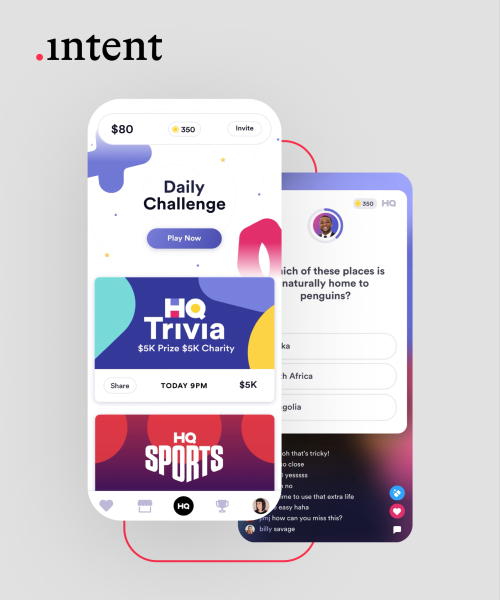
Intent has developed more than 160 apps, over 50 MVPs, and has been a Think Partner to HQ Trivia, Oura, Block, Keeps, iHeartRadio and many more startups and scaleups. Some of them were backed by tier-one VCs, such as a16z, FirstMinute Capital, Lerer Hippeau and Canvas Ventures...
For instance, we joined the HQ Trivia team, because they were looking for a solid partner to work with them on several experiments that would take their product to another level.
We’ve started with writing a custom HLS streaming engine for their Android app, a project to test how our cooperation would go. We’ve achieved it in a record time of 3 weeks, several times faster than their own implementation on iOS, and since then, we’ve been an integral part of their product team, designing and building their mobile apps as well as their streaming platform.
Would you like to work with the company that brought HQ Trivia to another level?
The year that Tucows, a well-known repository of downloadable software, first went online. The repository was built by Scott Swedorski, a technology enthusiast in Flint, Michigan, who spotted a need for a central resource for basic internet software. Swedorski’s work, while not initially intended to be commercial, proved the basis of a long-running company that came to prove an essential part of the early internet. After all, we needed software to get on the internet, right?
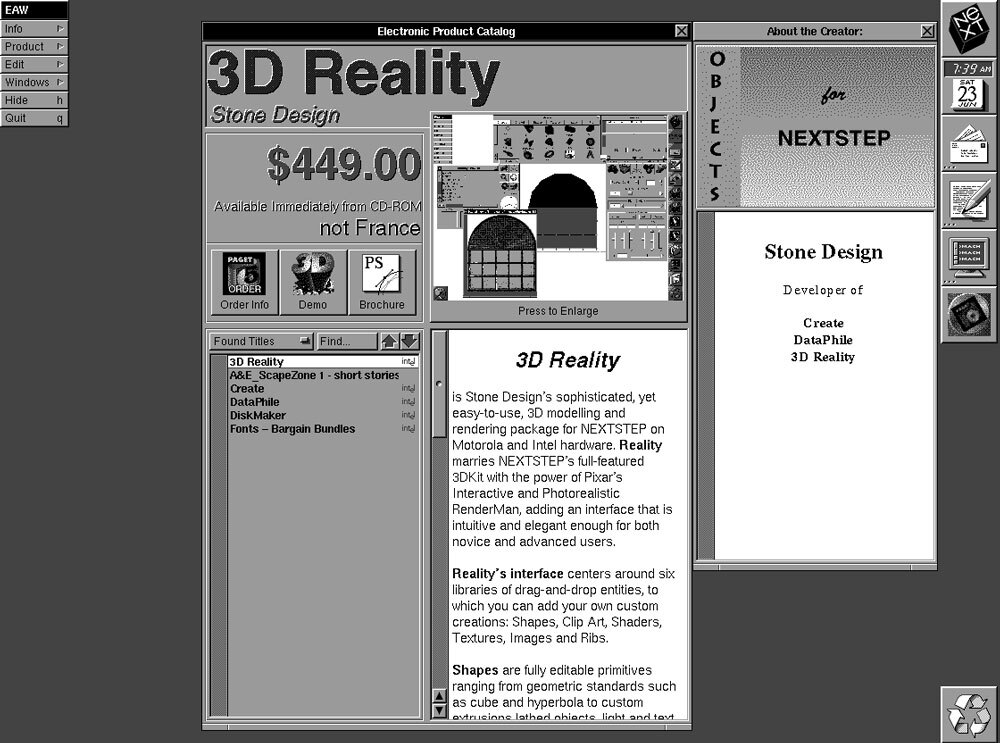
An example of the Electronic AppWrapper, a program for NeXT computers that could be used to distribute software digitally. (via AppStorey)
The app store that generally gets the nod for being first dates to the early 1990s, on a platform that was responsible for a lot of software firsts. I’m, of course, talking about NeXT, the platform on which the World Wide Web came to life and whose object-oriented approach to programming became a big part of what has made iOS so successful.
That software is called the Electronic AppWrapper. (See, it had app in the name way back in 1993!)
It did not exactly have the same kind of distribution method that one might expect for a modern app store, however. Really, what it did that is incredibly clever was that it took the shareware CD-ROM and made it into something that allowed for trials.
NeXT was a good platform for this in part because of its initial target audience—since the NeXT Cube tended to focus on educational and research settings, those settings were often networked well before PC and Mac equivalents, so people were able to purchase software online before other markets.
In fact, Electronic AppWrapper developer Paget Systems, which initially built a print version of the AppWrapper, made this very point in a 1992 article first proposing the idea:
The NeXT community is a perfect testbed for electronic distribution. The market is still small; we know where almost all of the computer owners are, and the community is more fluent with networking than most. And we have more than our share of creative people willing to tackle problems in new ways.
Also helping matters: Since NeXT systems were rare, users of this platform didn’t really have the advantage of being able to go to Radio Shack to purchase software, so it was either do everything through the mail, or go electronic.
Paget Systems’ great gift to the app store concept was the process it enabled. A 1993 issue of NeXTWORLD described the benefits of the tool like this: “To order by e-mail, just click a button; the application automatically displays an order form, asks for your credit-card number, and sends an encrypted message to Paget.”
That sounds pretty simple, right? It was, and it it’s not all that dissimilar to how we do things today.
(Side note: Jesse Tayler, who helped develop Electronic AppWrapper, has put up an informative documentary website highlighting the history of NeXT and the innovations the company helped to enable—including this. A highlight is Tayler’s discussion of successfully demoing the Electronic AppWrapper to Steve Jobs.)
— Tim Choate, the president of the firm Online Interactive, discussing the company’s atOnce online software store, which was one of the first examples of a traditional app store for Windows computers. As NetworkWorld explained in 1996, the atOnce software store was something of a test, complete with Microsoft’s blessing, to see if application distribution of commercial software over network mediums was even possible. The process required a more secure approach, at Microsoft’s behest. It should be noted that atOnce provides an interesting case—as it was effectively the app store for the AOL era (along with a very early web presence), though it quickly went away.

The Digital River website, as it appeared in 1998. (via Internet Archive)
Joel Ronning probably doesn’t get the credit he deserves in the grand scheme of things, but he is a figure in this discussion that matters.
In the 1980s, he spent time focused on the Macintosh market, selling software and distributing white-label accessories as well. This gave him an understanding of the digital market, so he could see all the flaws of the retail approach up close.
Around 1993 or so, he had a revelation that proved prescient: downloadable commercial software was going to be big. Really big. Big enough that he should spend the next few years developing processes for making the ideas around secure downloadable software workable, and patenting them. And building a company around them. And turning them into something that other companies would likely want to use.
Ronning’s work led to the creation a dozen patents—and a company called Digital River that could handle the encryption and distribution of applications. Not that anyone knew how to properly contextualize the idea at that early stage. In a 1997 profile with the Minneapolis Star-Tribune, columnist Dick Youngblood tried, and came up with this:
What Digital River has created is an enormous virtual warehouse containing tens of thousands of software products offered by hundreds of developers and retailers through their individual Web sites.
In simple terms, the system gives customers the ability to download their software choices with a minimum of fuss and a maximum of security for the credit card numbers and other personal data required for the transaction. I like to think of the operation as sort of the Supervalu of electronic software wholesaling.
Imagine having to describe something that people do over the internet on a daily basis without being able to use the terms “app store” or “cloud,” nor the frame of references that come with those terms, and that’s probably what you might come up with.

A patent drawing by Digital River that showed an early example of its digital-distribution technology, which included encryption functionality. Ronning has a lot of patent filings to his name.
The approach Digital River took in this early stage is actually quite similar to what we think of as an app store today—including the idea that the middleman is going to take a cut. (Digital River took just 20 percent, rather than Apple’s infamous 30 percent cut.)
But one difference is that the company represented a provider of purchasing services—i.e., it built the tools for individual companies to create their own storefronts, rather than becoming an app-store player itself. This model worked for them. By the year 2002, Digital River (a still-active company!) had more than 32,000 customers according to NetworkWorld, with roughly a third of those representing three quarters of Digital River’s sales.
“Year over year we continue to see more products purchased digitally.” Ronning said in a NetworkWorld interview. “People are getting more comfortable with getting a digital file than they were one, two or six years ago. That’s good news because it allows us to deliver a product halfway around the world in a matter of seconds.”
And hey, because the company was in a position to provide the technical know-how of running an app store, there was at least one case where Digital River was tapped to manage someone else’s app store—the creation of Research in Motion’s Blackberry App World in 2009.
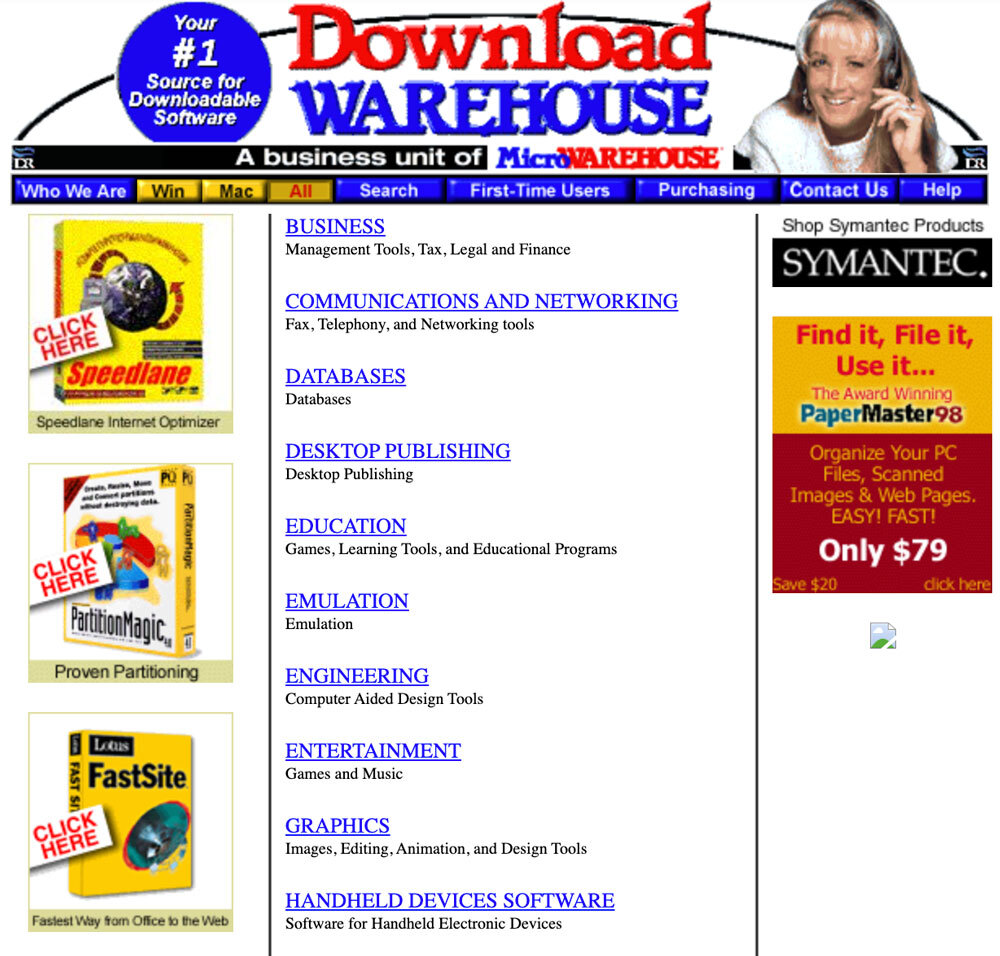
Download Warehouse, a.k.a. what app stores would look like if we made no changes to our approach between physical and digital distribution. Fun fact: This is what the atOnce website evolved into. (via Internet Archive)
Not every site was a winner, of course: When looking for info about app stores, I ran across this website on the Internet Archive that literally sold digital software as if it was still in a shrink-wrapped box, which made me crack up so hard. The backend? Digital River.
In many ways, the success of the app store was just as much about the packaging—i.e., the way consumers were pitched about the idea, rather than the shrink wrap—as the commerce itself.
The year StarCode Software, a developer of software for the BeOS operating system, was formed. The company built PackageBuilder and SoftwareValet, which combined together to become one of the first graphical package managers purpose-built for an operating system—and one Be acquired in 1998 and integrated into the operating system.
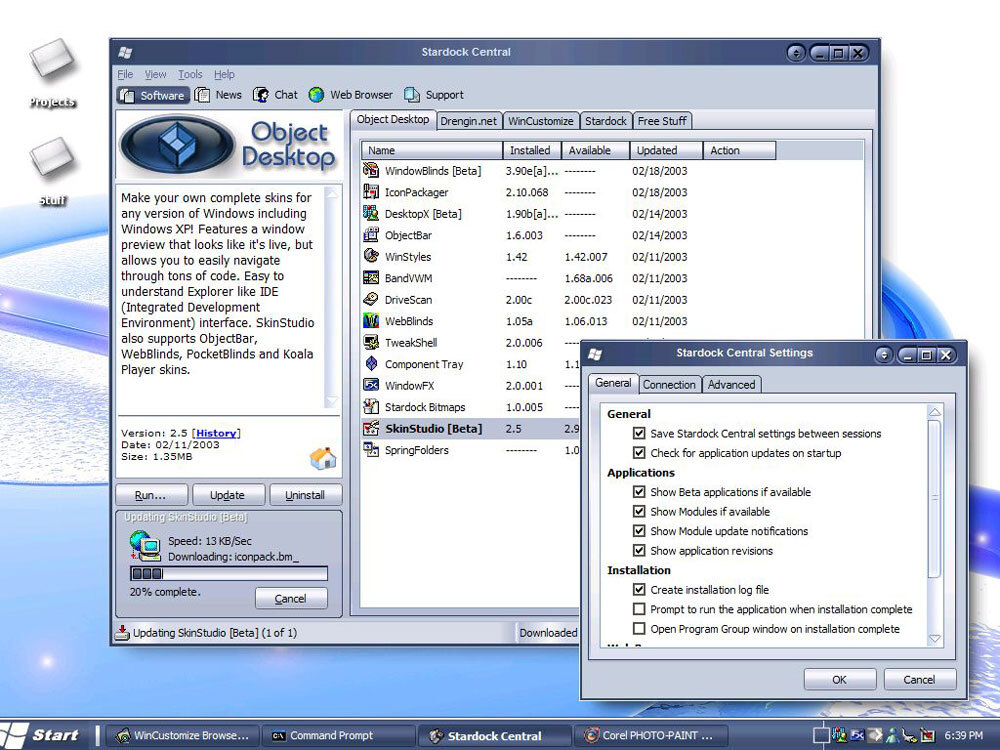
Stardock Central, a digital distribution service produced by the customization-focused company Stardock.

_The NTT DoCoMo NEC N904i, a phone that supports the formative i-mode network, considered the first mobile app store ecosystem. (via Wikimedia Commons)_
Thinking less about the maker of the phone itself or its general functionality, the mobile phone represents something about technology that a regular desktop computer doesn’t—it is intended as a full package, one that is hermetically sealed and managed by its maker and distributor.
Because it started from a different place, the expectation is different. That expectation creates tension for power users who wish that their phones or tablets worked a little more like their laptops, but on the other hand, the devices aim broader for a reason.
And one can point the reason for the expectation that applications would be managed by the provider. After all, the first mobile app store that feels like what we got with the modern App Store or Play Store came from a mobile company—Japan’s NTT DoCoMo released i-mode, a service that offered access to digital services through their phones. It worked particularly well in Japan because home internet was rare at the time when i-mode was first released in 1999, meaning i-mode was many Japanese users’ first experience with an internet-style service.
As The Japan Times noted in 2011, the reason i-mode succeeded (and spawned many imitators) was the tight integration of payments and software:
For those of you who may not know, i-mode is the mobile Internet-access service built into cell phones from Japanese communication giant NTT Docomo. It costs ¥315 per month to use and includes the i-mode network, which is Docomo’s closed system, separate from the Internet at large. Within this network there are “official” i-mode sites, which are only accessible from an i-mode enabled cell phone. On sites such as these, users can purchase goods and services and have the payment appear on their cell phone bill. This cell phone-integrated-payment is what makes the i-mode system so special.
Other companies tried to do this same thing during the early 2000s, including firms like Nokia, to mixed levels of success, but the connective tissue was that the phone was treated like an integrated experience of purchasing, distribution, and usage, rather than a vessel for applications.
Perhaps this integration explains, in the present day, why Apple has ramped up attacks against sideloading (or allowing the installation of external applications outside of an App Store experience), something that nearly other mobile platform (including Android) has long allowed. As it wrote in a white paper it recently released:
Allowing sideloading would degrade the security of the iOS platform and expose users to serious security risks not only on third-party app stores, but also on the App Store. Because of the large size of the iPhone user base and the sensitive data stored on their phones—photos, location data, health and financial information—allowing sideloading would spur a flood of new investment into attacks on the platform.
Mobile phones have been built with this expectation that the whole experience is seamless and managed by the hardware developer—and at one point, the mobile provider even played a significant role. In some cases, it still does.
But one wonders how strong Apple’s case against sideloading will actually be, given that, y’know, it also sells desktop computers that allow sideloading … or as we call it over that way, downloading and installing apps from the Web.
It’s long been said that Apple, when it released the iPhone, launched a device so compelling that it made people forget that there was years of prior art that predated the moment.
In many ways, the App Store made people forget about app stores. It was such a brilliant concept, idea, and execution that when Steve Jobs announced it in 2008, people basically ignored the nearly two decades of prior art that wasn’t even particularly well-hidden.
In some ways, the move to centralization was arguably disappointing, because it wasn’t perfect, and it put a middleman in control. Apple’s approach to the digital storefront had flaws—most notably the size of its cut and the weirdness of putting a single company’s moral compass in charge of the apps that people downloaded.
But we can look at the positives of their approach as well, and sort of the element that they nailed that few others were able to in quite the same way. The integration of the App Store into the operating system made both better; the integration of commerce into the App Store using a common system solved the problem of having to give a credit card number out every time you wanted to download an app; and the integration of a development strategy that worked in tandem with the App Store gave (and still gives) Apple a reason to constantly improve its programming interfaces so they remain at the top of their class.
No developer of a prior app storefront had been able to nail down quite this mix (with Steam possibly getting the closest), which explains why it was so effective when Apple did it.
But prior art is prior art, and one hopes that the technology industry takes a step back to learn the lessons from both the Apple App Store’s strengths and weaknesses going forward. After all, so many others got there first.
--
Find this one an interesting read? Share it with a pal!
And thanks again to our sponsor, Intent, for helping give today’s issue a push.

Ernie Smith is the editor of Tedium, and an active internet snarker. Between his many internet side projects, he finds time to hang out with his wife Cat, who’s funnier than he is.
Find me on: Twitter
Get more issues in your inbox
Jun 18, 2021  ](https://tedium.co/2021/06/18/sparks-band-documentary-tribute/)
](https://tedium.co/2021/06/18/sparks-band-documentary-tribute/)
Source: "App Store Predecessors: Many Early Attempts at Digital Distribution"
(Also relevant to #118.)
 Roma's Desktop Application
Roma's Desktop Application
 The current release version of Whalebird for Windows.
The current release version of Whalebird for Windows.
Here's the text of the inquiry I just submitted to the Contact form on https://roma.rocks:
Sent via the Contact form on the Roma website.
Hello!
First, I hope you do not interpret this message with any sort of hostile intention. I'm genuinely just curious.
I've been writing a comparison of Mastodon apps on iOS for the past few weeks and I noticed that Roma appears to be the very same application which used to be called Mast. I DMed Mast's developer about it but haven't heard back. I also just noticed the same thing about the Roma desktop application - except that it appears virtually identical to Whalebird.
I have absolutely zero desire to have any negative impact on the federated social community at all with my app guide, but this sortof thing is hard not to mention. If you'd be willing to share any details about the story, I'd love it if you'd reach out.
Thanks for your time!

A reply already!
The text:
From l@leo.com
Sun 6/27/2021 1753
Hi David,
In both cases we funded the original developers of both Mast and Whalebird to create a branded whitelabel app specially made for Pleroma. The idea was to make Roma a cross platform brand/app. It didn't really work out so now we're working on a new app from scratch called Fedi for iOS and Android and releasing that as open source.
https://play.google.com/store/apps/details?id=com.fediverse.app&hl=en_US&gl=US https://apps.apple.com/in/app/fedi-for-pleroma-and-mastodon/id1478806281
I think Roma has been removed from the app stores as it's no longer supported.
Let me know if you have any other questions

A passionate and experienced product designer with cross-cultural background of China 🇨🇳, the Netherlands 🇳🇱 and Sweden 🇸🇪. Constantly reaching out to experience cultural differences, and further reflecting upon the perception between human, human and machine.
Technologies advance in an effort to bridge people closer, reduce further workload. However, do people truly feel the connectedness among each other? How do I as a designer, when experiencing these rapid updates, propose what is actually beneficial for a societal transformation?
Let’s explore together! I will bring along my key competencies:
Cross-cultural design / Experience design / Design thinking / Product Development
Feel free to grab my résumé 😊.
By ** ''
📱 download
Source code
2020, it was the year of breakout of Covid-19, that forced all of us to rely on digital platform no matter how critical some of us were towards digital addiction. We connect, we share, we emphaempathize with each other through various platforms on the digital world.
Still, censorship of content has been tightened unfortunately in mainland China. One of the social media platform named Douban which dedicates to discussions of movie, music, book, etc. also seen highly unpredictable taken down of user generated contents. This triggers a flow called Douban Refugee that many start to abandon social media platforms in mainland China, seeking alternative solutions to share freely.
This brings a boom of introduction of Mastodon, a decentralized social media platform that not only is free from censorship, but also maximize controlling of each’s data. Although a decentralized platform like Mastodon does require more involvement such as setting up own servers, many take the courage, following tutorials, some even without any technical background, setting up their own platforms to welcome Douban Refugees.
In light of this movement, it is evident back in 2020 that there are almost none user friendly mobile clients for Mastodon. There are few solutions with good designs but charges, and only exists within Apple’s ecosystem. With the aim of contributing to the community and to this movement, I decided to take my quarantine time to build an enjoyable mobile client for Douban Refugees.
My spare time of building multiple web solutions for SMEs allows me to level up on using React and JavaScript based technologies. React Native thus becomes the top choice, after evaluating the benefits of other frameworks such as Flutter. In a mobile application environment where users’ tolerance of failures and glitches is much less compared with website environment, a familiar framework contributes to the stableness of the final outcome.
Over past years, several addictive centralized platforms stick with many users in various forms. Based on their dominance, users are forced to accept whatever information they provide even though this has always been a hot topic. I remember when LinkedIn joined Facebook-alike to make their timeline not “timeline” anymore but suggestion based, as a user, I have no choice but to continue using their service in professional settings.
Decentralized platforms, on the other end, take a different standpoint that data belongs to all users, and there is no more “recommendation” by harvesting user data. Technically, without centralized computing power, such recommendation service is also not that feasible. From users perspective, how can we adapt ourselves back to a no recommendation based digital workld? And how can I design information display that still invites users to explore inside a linear timeline?
Platforms like Mastodon are open source, and have existed for some years where many people continues to improve it. Though there is hardly one solution or design that satisfies everyone. In open source world, this easily leads to complicated service offerings, similar to a corporate environment.
To build an application that connects to an existing protocol, understanding how data is structured and shared is crucial. While exploring Mastodon’s API, difficult decisions need to be made on what data is essential to be included, and why are they meaningful. By trying out existing third party mobile apps, immersing myself in its ecosystem, observing how other users are using it, I aggregate my learnings into practice, setting up tooot’s foundation structure.
My previous experience of cleaning up H&M’s app sets a clear starting point to define tooot app’s structure. The core consits of 3 needs: 1) what I can read; 2) what I can write; 3) what I have done. Bottom tab navigation is by far the best navigation approach when above purposes can be defined clearly.
In tooot, 2 tabs on the left dedicates to different timelines that a decentralized platform normally offers: my timeline, timeline on this particular server, and federated timeline. During closed and open beta period currently, there are user feedbacks suggesting to open up customization possibility of these timelines. This is yet to be discovered further after MVP.
The main tab in the center is where users can post updates. Unlike centralized platform that encourages users to post in order to retain his/her connections, observation suggests that, at least within Chinese community, willingness of posting or sharing is high when you feel you can connect to others easier without the worry of being censored.
The last 2 tabs focus on what a user has act upon, such as notifications, bookmarks, etc.
Technically, there are many “pages” that are shared between all these tabs such as the page to view a specific post. When building it, I learn a lot about that most times, it is not as simple as saying “let’s build a new page”. In order not to break above core navigation principles, retaining the scalability as well as user needs, threads need to be connected among all these considerations; or translating into a corporate setting, it is the true sharing and connecting between business, technology and design.
Currently at open beta stage, aiming at releasing first production version in April. Bugs fixing and minor experience improvements are being focused.
Main user feedbacks during this stage suggest below 3 key points:
Mastodon has followed a similar approach to Twitter that offers customized listing views. Furthermore Mastodon’s API as well as its official web client offers much more freedom to define customized way of filtering a timeline, such as based on certain saved hashtags, excluding fediverse, etc. There is no motivation from my perspective to provide a “main timeline” where like Twitter that personalized feed as well as inserting advertisements, still, what kind of structure and interaction pattern that can support such highly dynamic need will be explored after version 1.0.
Stay tuned!




29-06-2021 23:21
Social media apps should share the same social graph by implementing ActivityPub
I love joining new social apps! Last month, I signed up for Poparazzi as soon as it dropped. I was all for it! You could only post photos of others and not yourself? Sounds like a good antithesis to Instagram’s overcuration! I added contacts. I reacted to my friends’ Pop’s. I Pop’ed a friend.
And then I stopped using it.
It joined a host of other great apps—Dispo, Clubhouse, House Party, etc. All at one point promising to challenge Facebook’s Hegemony. All now deleted. What happened?
I believe new social apps’ growth stagnates because they don’t enjoy the network effects of Facebook. (I know this is not an original take.) However, I also believe you can circumvent this problem by implementing ActivityPub. It’s a decentralized social networking protocol standardized by the W3C. It allows you to tap into the networks of users from other apps that also implement the protocol. The user retention and discoverability benefits you’ll gain from the shared social graph just might outweigh the concerns around moat.
Back to the great apps that I have uninstalled. I stopped using them because I couldn’t find enough friends there. It wasn’t meaningful to post about a friend when they weren’t on the platform. It was less rewarding knowing that few of our mutuals would see it. Even with all the hype it gathered, Poparazzi couldn’t match Facebook’s Network Effects. Let’s not even talk about social apps that never made it to public awareness.
Moreover, my brain didn’t have the capacity for yet another social app. The burnout from keeping up with multiple apps is real—it’s the reason that people are begging for a messaging solution that integrates messages from multiple social platforms. If we could easily support integrated feeds, trying out a new app transforms from a daily intention to a single-installation action.
I think these retention problems are solved if your users could interact with each other across apps. Make use of the same social graph.
It’s like E-mail. We take it for granted that any email user can send and receive emails from anyone else with an email address. That’s because their various servers (e.g. Outlook and Gmail) implement SMTP. They are built in different ways and have different properties (e.g. spam filters) but they are all compatible at the protocol layer.
Why can’t social media behave the same way? ActivityPub (along with Matrix) is the most popular open social network protocol. I use Mastodon—the ActivityPub version of Twitter. And within it, I can follow any user from PeerTube—the ActivityPub version of Youtube. Here’s what PeerTube posts look like on my Mastodon feed.

Facebook is never going to fully release their social graph. Right now if your app uses the Facebook Graph API, you can only see a user’s friends if they too install your app. It benefits Facebook to set constraints. And nothing’s stopping them from removing their Graph API completely.
On their own, new social apps and your walled gardens can’t rival the big forest that is Facebook; but combining your growth efforts onto a large enough social graph just might. Consumers may not have the headspace to download a host of new apps, but they’d be willing to download one app that gave them access to social media innovations.
In a world where all new apps implement ActivityPub, users are more likely to stick to your new apps.
You also get discoverability and virality benefits out of the box. Your new social app’s users can now be followed and “retweeted” across their friends in all other networks. If they like the content, you’d create accounts on your app. This is the kind of organic growth that companies heavily rely on—remember Andreesen Horowitz pushing Clubhouse content all over your Twitter feeds last year?
In fact, the only truly successful new social media app in the last decade has been TikTok and it was in part due to the aggressive crossposting of TikTok videos onto other platforms. What if that crossposting were automatic?
And all these benefits come with relatively low engineering overhead. No need to chase down each app and integrate with them. You just have to handle a few GET and POST request endpoints.
To allow users outside your app to direct-message users on your app, your server would have to accept the following JSON object as a POST request from other apps. Your client would then retrieve it to display it.  Example 3 from ActivityPub specs
Example 3 from ActivityPub specs
Here, Alyssa from Social App has sent a personal message to Ben from Chatty app. The fields are straight-forward: recipient, sender, note.
If she wanted to post that to her servers, her server would set the to field to "https://social.example/alyssa/followers/". If she wanted to post a different content type, her server could extend the object. For example, this is an object that’s a Markdown:
 Example 8 from ActivityPub specs
Example 8 from ActivityPub specs
The tradeoff of adopting a shared open standard? You might lose your network moat.
But what’s the point of a network moat if it’s not big enough? SnapChat’s Stories idea was great but consumers preferred using the same feature on their much larger Instagram network. I don’t think consumers would’ve switched to Instagram if most of their network was already on Snap. You can build up moats in other ways, such as in building superior models of social media—be it in content type, curation, discovery, fact verification, or moderation.
Fighting a monopoly will require collective power. The Fediverse offers a way for social apps to band together to have a shot at winning. Shoutout to the ActivityPub team and all early adopters for showing us a way to build a world like this.
Yours sincerely,
Michelle
Your huge fan
==6142== Words
YE STUBBORN DOUBTERS, at some point between now and FUNNY RAVE start at 5PM CST, I am going to demonstrate the Mastodon onboarding process (entirely on my phone) before authorizing the new account with 20 SEPARATE MASTODON APPS in LESS THAN 5 MINUTES. all live, https://twitch.tv/dieselgoth
Shortlink -
https://bit.ly/imastodon